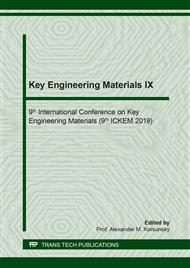p.419
p.426
p.435
p.440
p.445
p.452
p.459
p.465
p.472
Numerical Modeling of PZT- Piezoelectric Composites with Passive and Active Polymer Matrix
Abstract:
Piezoelectric composite materials with a polymer matrix are important for underwater acoustic and biomedical imaging applications. The dependence of electromechanical properties of piezoelectric composite on constituent material characteristics and shape of piezoelectric inclusions is a central problem that provides the opportunity to tailor the performance of piezoelectric composites according to design needs. A numerical model has been developed to investigate the electromechanical properties of 1-3 piezoelectric composites with a passive and active polymer matrix. Maxwell Homogenization method is employed to homogenize the solution domain. It is demonstrated that the use of PVDF as an active polymer matrix has a significant influence on piezoelectric charge coefficient d31, hydrostatic coefficient dh, voltage coefficient gh, and hydrophone figure of merit ghdh when compared to the passive Araldite-D polymer matrix. Overall, a 5 to 30% volume fraction of PZT-7A fiber inclusions in an active polymer matrix is the optimum ratio that has a significant effect on piezoelectric properties. The accuracy and effectiveness of homogenized material constants were verified by comparing the derived composite properties with experimental work published elsewhere. These results provide much needed intuitiveness in the development of piezoelectric polymer composite with better performance for transducer applications.
Info:
Periodical:
Pages:
445-451
Citation:
Online since:
September 2019
Price:
Сopyright:
© 2019 Trans Tech Publications Ltd. All Rights Reserved
Share:
Citation:


